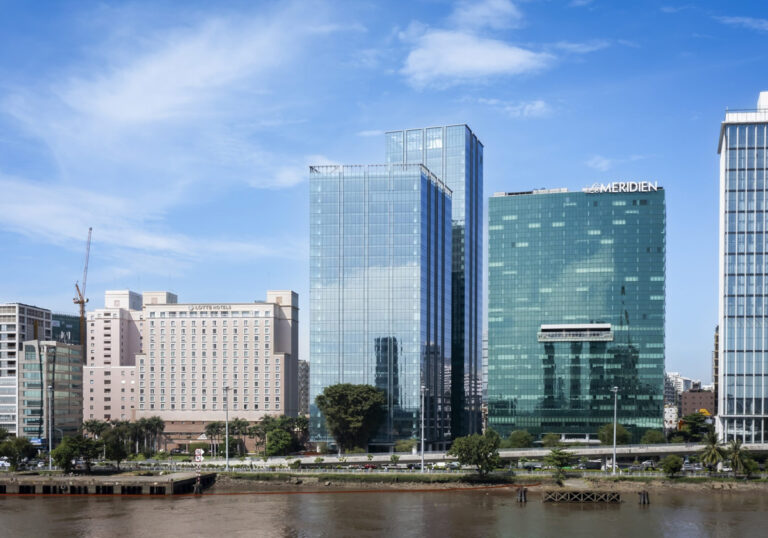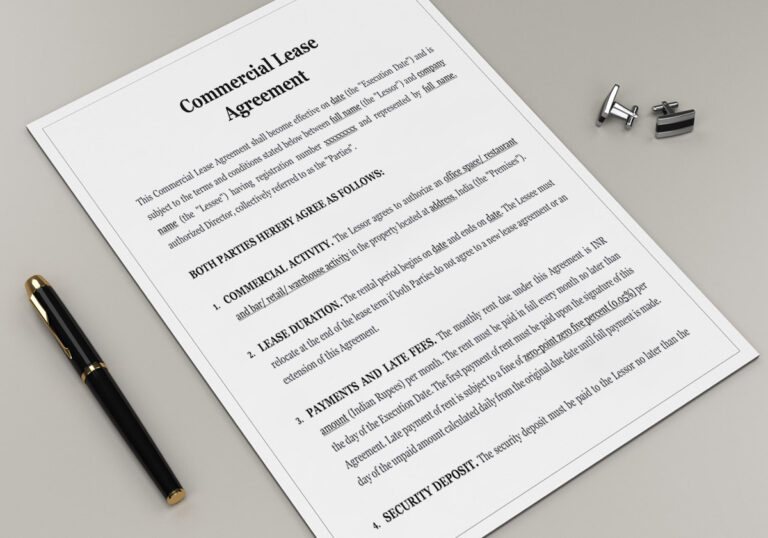Choosing Between Short and Long Office Lease in Vietnam

In the context of an increasingly volatile office real estate market, choosing between short-term vs long-term office lease Vietnam has become a strategic decision for businesses. Each lease type offers its own benefits and challenges, depending on the organization’s needs, business goals, and financial capacity. Understanding the pros and cons of each option helps businesses optimize the efficiency of their workspace usage.
Table of Contents
1. Understanding Short-Term and Long-Term Office Leases
As Vietnam’s commercial real estate market becomes increasingly dynamic and competitive, choosing between a long term lease vs short term lease has become a strategic decision for businesses.
1.1 Short-term office lease
Short-term office leases typically have durations ranging from a few months up to just under 12 months. This type of lease is often associated with flexible workspace solutions such as coworking spaces, serviced offices, or temporary rental agreements that allow businesses to quickly adapt their office needs. These options are especially popular in major urban centers like Ho Chi Minh City and Hanoi, where demand for flexible office solutions is steadily increasing.
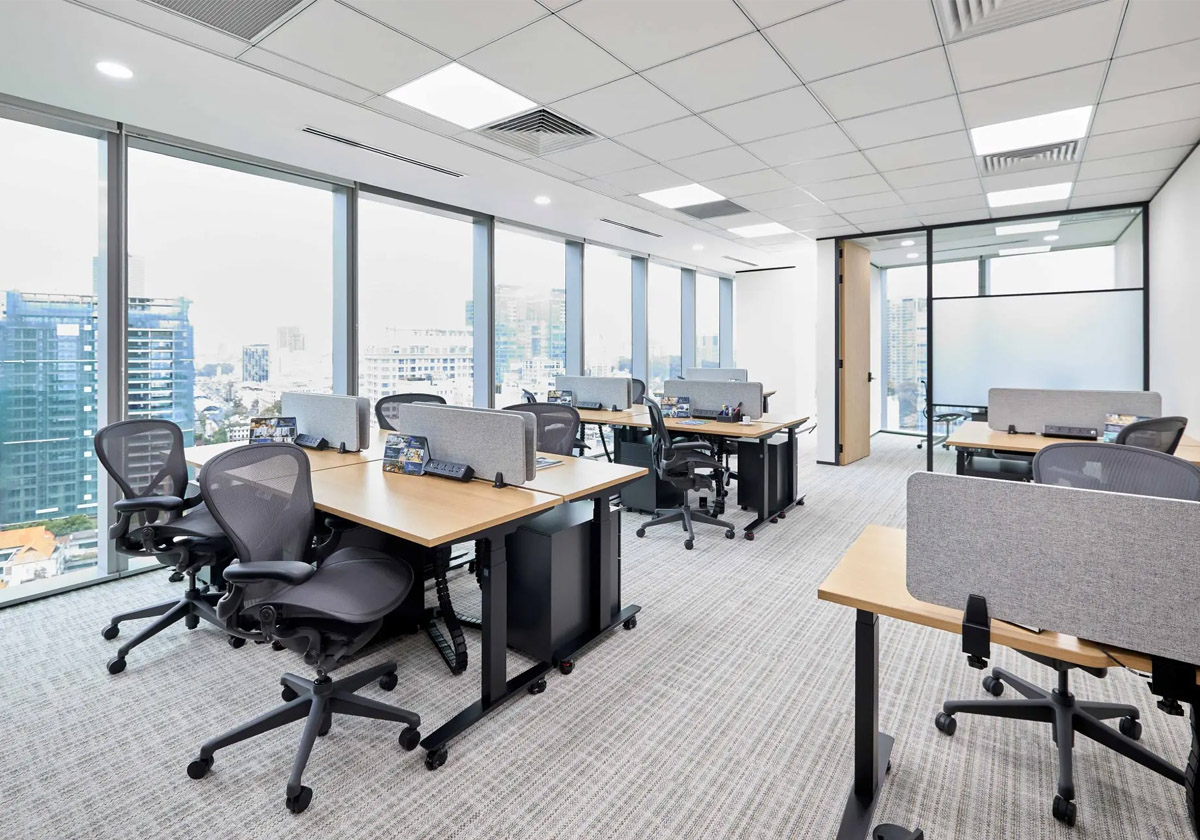
Short-term leases are designed to meet the needs of businesses that require flexibility, such as:
– Startups looking to minimize upfront costs.
– Representative offices setting up a temporary base.
– Project teams needing space for limited durations.
– Companies testing new markets before making longer-term commitments.
1.2 Long-term office lease
Long-term office leases usually last from 2 to 10 years or more, providing a stable foundation for well-established businesses with long-term development plans. This type of lease is typically associated with traditional office spaces, often located in Grade A or B office buildings within central business districts.

Long-term leases are particularly favored by:
– Large corporations with strong and stable financial capacity.
– Well-established businesses with long-term operational plans.
– Government agencies that need stability and clear legal terms over the long term.
– Multinational corporations that have established a stable presence in the Vietnamese market.
Both types of leases offer distinct advantages and disadvantages that need to be carefully evaluated in the dynamic Vietnamese market. By thoroughly understanding these leasing options and their implications, businesses can make informed decisions that align with their operational goals and market strategies in Vietnam.
2. Pros and Cons of Short-Term Office Lease
In today’s fast-changing business environment, flexibility has become a top priority for many companies. Short-term office leases have emerged as a practical solution to meet these needs, offering a range of benefits while also presenting certain limitations. Understanding the pros and cons of this leasing model is essential for businesses to make informed decisions.
2.1 Pros of Short-Term Office Lease
– High flexibility: Short-term leases allow businesses to easily change office location or scale based on operational needs. For example, a tech startup can quickly scale up or down its workspace based on growth pace without being tied to a long-term lease.
– Low initial investment: Short-term office spaces, especially serviced offices or coworking spaces, are often fully furnished and equipped with utilities (electricity, water, internet) as well as support services such as reception, security, and cleaning. This significantly reduces initial setup costs compared to traditional office leases, where businesses have to invest in furniture, equipment, and renovation expenses.
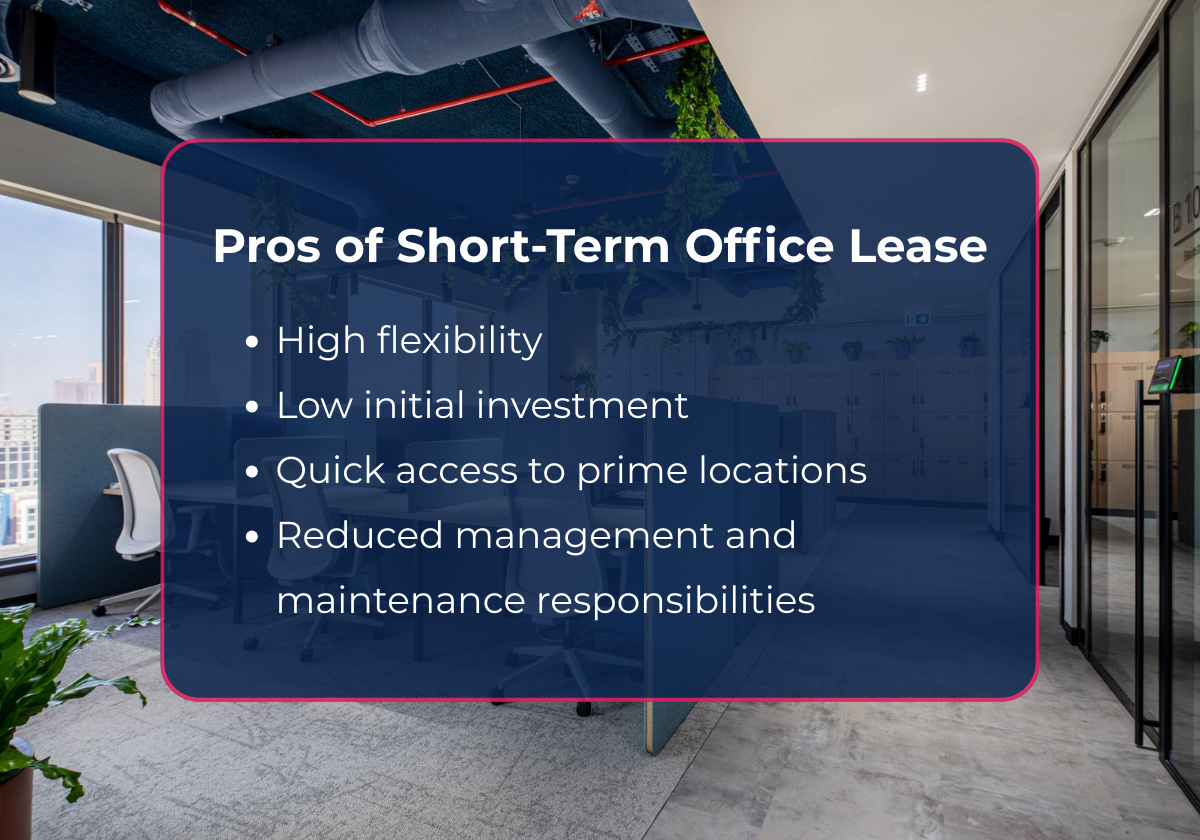
– Quick access to prime locations: Short-term office leases often allow businesses to access prime locations in central business districts without the long-term financial commitment. These locations typically come with high rental costs, but serviced offices and coworking spaces offer more affordable options. This allows small or newly established businesses to build a professional image and connect with a dynamic business ecosystem.
– Reduced management and maintenance responsibilities: Short-term office leases often include maintenance, cleaning, and technical support services such as IT troubleshooting or office equipment repairs. This allows businesses to focus on their core operations without the burden of managing facility-related issues.
2.2 Cons of Short-Term Office Lease
– Higher monthly costs: Although the initial costs are low, short-term lease rates per square meter are typically much higher than those of long-term leases. Due to the short contract duration and ease of termination, landlords often apply higher rates to offset risks. In addition, if a business continues to renew short-term leases over an extended period, the total cost may far exceed that of signing a long-term lease from the beginning.
– Limited customization options: Short-term office spaces often restrict a company’s ability to customize the layout or design to fit specific branding or operational needs. This is because providers typically favor standardized setups to accommodate multiple clients efficiently. As a result, businesses may find it challenging to create a fully personalized work environment that reflects their identity or supports specialized functions.
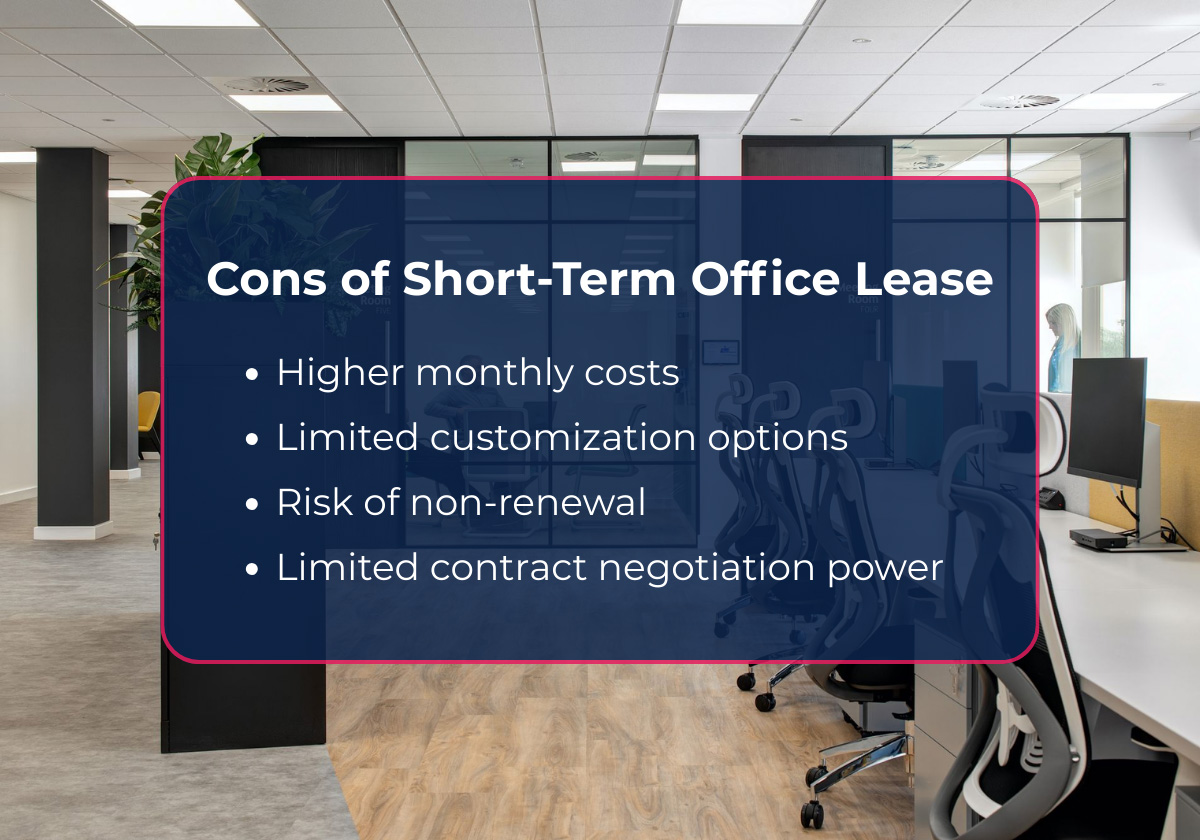
– Risk of non-renewal: Short-term leases often do not guarantee contract renewal, especially in Vietnam’s real estate market where occupancy rates are high (over 90% in central areas). If landlords or office providers decide to raise rent or prioritize other clients, businesses may be forced to relocate, causing operational disruptions and affecting stability.
– Limited contract negotiation power: Compared to long-term leases, businesses renting short-term offices often have less room to negotiate contract terms such as rent price, lease duration, or additional benefits. Landlords or providers usually offer standardized service packages, making it difficult for businesses to negotiate terms tailored to their specific needs.
3. Pros and Cons of Long-Term Office Lease
With extended lease terms, long-term office leases offer stability and opportunities for cost optimization but also come with several challenges. This section will analyze in detail the pros and cons of long-term office leasing, providing essential information to help businesses make decisions that align with their goals and operational needs in the Vietnamese market.
>> See more: Office Space Lease Agreement Template in VietNam
3.1 Pros of Long-Term Office Lease
– Stable rental costs: One of the biggest advantages of long-term office leases is the ability to fix rental costs throughout the contract period, helping businesses avoid fluctuations in the real estate market. In recent years, office rental prices in central areas of Ho Chi Minh City and Hanoi have increased significantly due to high demand and limited supply. In this context, a long-term lease contract can lock in lower rental rates, providing a financial advantage over the long term.
– Workspace customization: A long-term lease provides businesses with greater autonomy to design and modify their office space to match operational needs and brand identity. This enables companies to invest in tailored layouts, install technology systems, or build specialized areas such as creative zones or laboratories, enhancing operational efficiency and corporate image.

– Ensuring business continuity: A long-term lease provides stability in workplace location, allowing businesses to maintain a fixed address in key commercial areas. This consistency not only facilitates daily operations but also helps attract talent and build trust with partners and customers. It is especially critical in sectors such as finance, legal services, or manufacturing, where geographic stability plays a vital role in sustained business operations.
– Stronger negotiating power: In Vietnam, Grade A office buildings such as Keangnam Hanoi Landmark Tower or Vietcombank Tower often offer attractive incentives to long-term tenants, particularly multinational corporations and large enterprises. Businesses may negotiate benefits such as rent-free periods during the initial months, fit-out allowances, or more flexible lease renewal terms.
>> See more: What is Fit Out? How long does it take to Fit Out of the office?
3.2 Cons of Long-Term Office Lease
– High initial costs: Long-term office leases typically require a significant upfront investment, including security deposits (usually equivalent to 3 – 6 months’ rent), fit-out expenses, and costs related to equipment or furnishings. This can create financial pressure for small and medium-sized enterprises or companies with limited capital.
– Lack of flexibility: In Vietnam’s rapidly evolving economic landscape, being tied to a long-term lease can limit a business’s ability to seize opportunities for relocating to more strategic locations. This rigidity may hinder quick adaptation to market changes or shifts in operational needs, such as expanding, downsizing, or relocating.
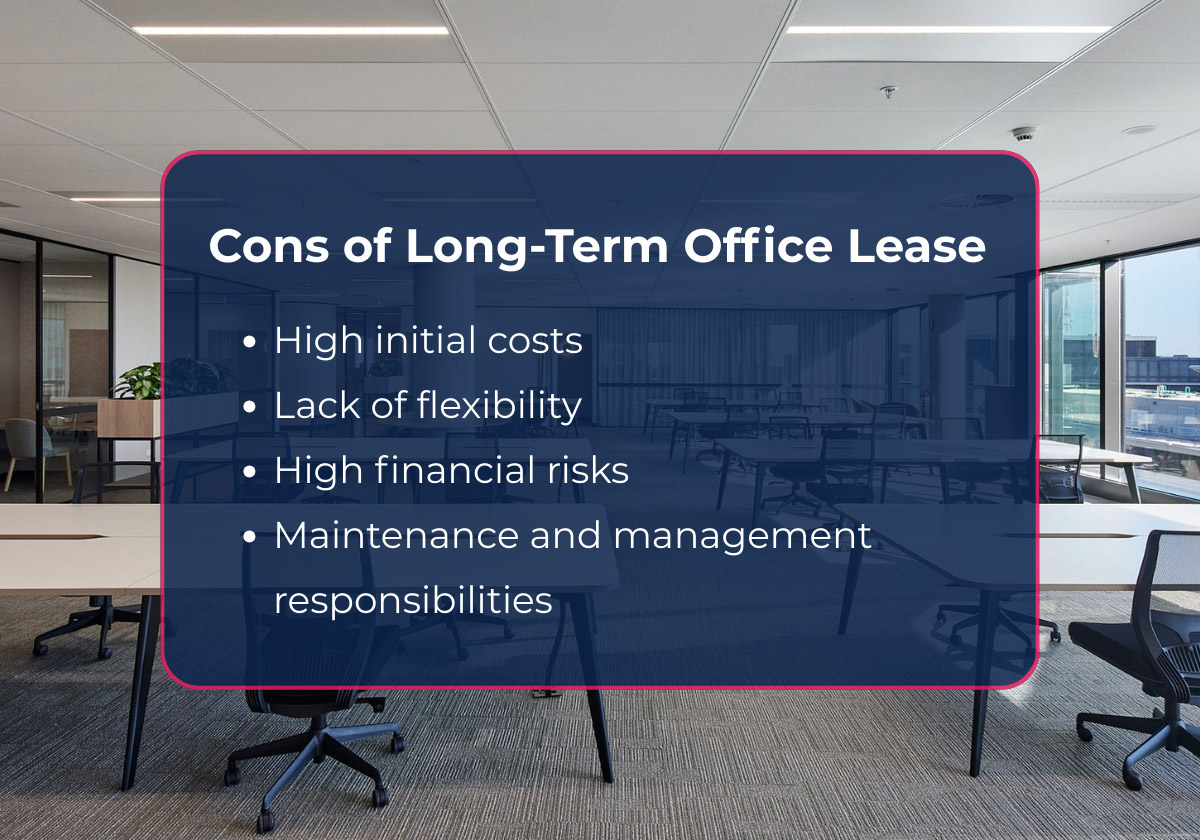
– Financial risks: In Vietnam, lease contracts often include strict clauses regarding early termination, requiring businesses to either continue paying rent or find a third party to transfer the lease. This can create significant financial burdens, especially when a company faces business difficulties or needs to change its strategy abruptly.
– Maintenance and management responsibilities: Unlike short-term leases, long-term office leases may require tenants to take full responsibility for maintenance, repairs, and compliance with building regulations. This increases overall operational costs and necessitates a dedicated facility management team within the business.
4. Key Factors to Consider When Choosing Lease Term
With the rapid development of various office rental models, Vietnam’s office market offers numerous opportunities but also presents distinct challenges for businesses. Among these, choosing between short-term vs long-term office lease Vietnam is a strategic decision that requires businesses to carefully evaluate multiple factors. They may include:
4.1 Stage of development and business objectives
The stage of business development plays a key role in determining the appropriate lease term. Startups or rapidly growing companies often prefer short-term leases to maintain flexibility. Conversely, established businesses such as financial corporations or manufacturing companies usually opt for long-term leases to ensure stability and build a lasting brand image.

For FDI companies entering a new market, short-term office leases are often the preferred option. This model allows businesses to test the market potential without committing to long-term financial and operational obligations, thereby minimizing risk. This makes short-term leasing the best lease type for FDI companies in Vietnam during their initial market entry phase. Once the business stabilizes and growth potential is confirmed, transitioning to a long-term lease can help optimize costs and solidify operations.
4.2 Business financial capacity
Financial resources heavily influence a company’s choice between short-term vs long-term office lease Vietnam.
- Short-term leases typically require lower upfront costs, as spaces are often pre-furnished and include bundled services such as internet, cleaning, and maintenance. This makes them suitable for small businesses or new market entrants with limited budgets.
- In contrast, long-term leases involve higher initial investments, including a security deposit and fit-out expenses. However, companies with strong financial resources, such as multinational corporations, can leverage long-term leases to lock in lower rental rates and hedge against future price fluctuations.

Accordingly, businesses need to assess their cash flow, long-term budget, and risk tolerance to determine the most suitable lease duration.
4.3 Industry Characteristics
The nature of a business’s industry greatly influences the choice of office lease term. Sectors that demand flexibility and rapid innovation – such as technology, advertising, or e-commerce – tend to favor short-term leases to quickly adapt to shifts in business strategy or market trends. In contrast, industries requiring stability and long-term investment in infrastructure usually prefer long-term leases to develop spaces tailored to their specialized needs.
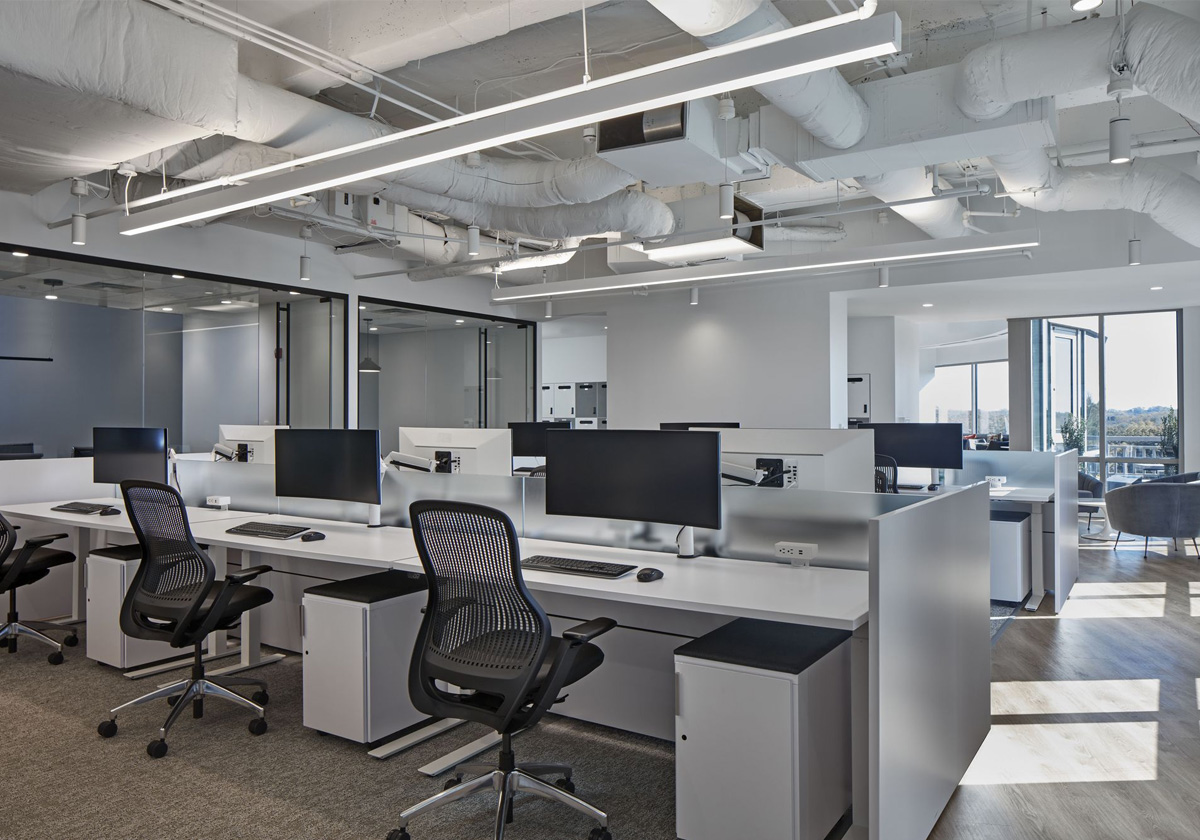
4.4 Market conditions
Vietnam’s office real estate market is subject to significant fluctuations, especially in major cities like Hanoi and Ho Chi Minh City. Researching market trends is crucial when deciding between a short-term or long-term lease.
For instance, during periods of rising rental prices, securing a long-term lease can help businesses lock in lower rates and achieve cost savings over time. On the other hand, in a market with signs of oversupply, short-term leases offer more negotiating leverage and allow businesses to take advantage of lower rates without long-term commitments.

4.5 Expansion and growth plans
Businesses also need to assess their growth trajectory when choosing the lease term. Companies planning rapid expansion – such as those in technology or e-commerce – often prefer short-term leases for flexibility to adjust office space according to staff size or operational needs. Conversely, businesses with stable, steady growth plans typically opt for long-term leases to secure sufficiently large and consistent space for sustained operations.

Choosing between short-term vs long-term office lease Vietnam depends on various factors such as financial capacity, growth plans, industry characteristics, and market conditions. Each option offers distinct advantages and limitations, suitable for different development stages and operational goals. Carefully evaluating these factors before making a decision not only helps minimize risks but also supports sustainable growth in today’s dynamic business environment.
>> See more: How to Negotiate an Office Lease – Key Tips for a Better Deal

Editor and content team manager at Maison Office.
With over 5 years of experience in consulting and extensive content editing in the real estate services and interior design field. Sharing valuable information with customers, partners, and attracting millions of views.


